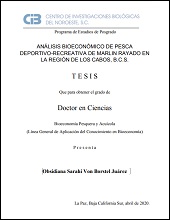| dc.contributor.advisor | Beltrán Morales, Luis Felipe | |
| dc.contributor.advisor | PONCE DIAZ, GERMAN | |
| dc.contributor.author | VON BORSTEL JUAREZ, OBSIDIANA SARAHI | |
| dc.date.issued | 2020 | |
| dc.identifier | https://cibnor.repositorioinstitucional.mx/jspui/handle/1001/1922 | |
| dc.identifier.uri | http://dspace.cibnor.mx:8080/handle/123456789/3144 | |
| dc.description.abstract | "La región de Los Cabos Baja California Sur es reconocida internacionalmente por sus altas tasas de captura de marlin rayado (Kajikia audax), propiciando una considerable derrama económica por concepto de pesca deportivo-recreativa. Anteriormente esta actividad fue analizada desde un enfoque biológico o económico, el presente estudio analizo esta actividad considerando los aspectos biológicos, económicos e incluyo un análisis de características socioeconómicas del pescador recreacional por medio del Método Costo de Viaje. El motivo de incluir estas variables en el análisis es identificar el estado actual del recurso, conocer los beneficios de la técnica de captura y liberación para el recurso y la perspectiva de la misma por parte del pescador recreacional. El objetivo del presente estudio fue identificar por medio de un modelo bioeconómico si la práctica de la técnica “capturar y liberar” permite incrementar la disponibilidad del recurso y si esto afecta la operación de la flota recreativa. Los resultados del modelo indicaron que el estado del recurso es saludable, indicando que la práctica de pesca recreativa de manera tradicional no pone en riesgo el recurso, sin embargo, la implementación de la técnica captura y liberación para la especie marlin rayado (Kajikia audax) favorece la disponibilidad del recurso, ya que permite llegar en un mediano plazo a cifras cercanas a la biomasa inicial. En lo referente a la operación de la flota se identificó que las embarcaciones que generan mayores rendimientos económicos son aquellas de 32, 31 y 28 pies, en lo referente a los viajes de pesca, predominaron aquellos con duración de 5 horas, acudieron 3 pescadores promedio por viaje y el promedio de viajes realizados durante la estancia fue de 1. La aceptación por la práctica de la técnica “capturar y liberar” fue favorable, al igual que el porcentaje de pescadores que continuarían acudiendo a la zona pese a que únicamente pudieran practicar pesca deportiva en dicha modalidad, lo que hace evidente la creciente concientización de los usuarios por llevar la actividad de manera sustentable. En lo que se refiere al pescador recreativo, se determinó el perfil del pescador que acude a la zona de Cabo San Lucas conforme a los datos recabados durante la aplicación de encuestas y los resultados del método costo de viaje, mismo que permitió generar un calculó de una derrama de $82,054,500 dólares..." | es |
| dc.format | pdf | es |
| dc.language.iso | spa | es |
| dc.publisher | Centro de Investigaciones Biológicas del Noroeste, S.C. | es |
| dc.rights | Acceso abierto | es |
| dc.subject | Bioeconomía, sustentabilidad, perfil pescador, captura-liberación, estrategia pesquera | es |
| dc.subject | Bioeconomics, sustentability, angler’s profile, catch-release, fishing strategy | es |
| dc.subject.classification | ECONOMÍA SECTORIAL. TURISMO | es |
| dc.title | ANÁLISIS BIOECONÓMICO DE PESCA DEPORTIVO-RECREATIVA DE MARLIN RAYADO EN LA REGIÓN DE LOS CABOS, B.C.S. | es |
| dc.type | doctoralThesis | es |
| dc.dirtesis.grado | Doctorado en Ciencias en Bioeconomía Pesquera y Acuícola | es |
| dc.dirtesis.disciplina | Bioeconomía Pesquera y Acuícola | es |
| dc.dirtesis.universidad | Centro de Investigaciones Biológicas del Noroeste, S.C. | es |
| dc.dirtesis.facultad | Posgrado en Bioeconomía | es |
| dc.description.abstracten | "Los Cabos Baja California Sur region is internationally recognized for striped marlin (Kajikia audax) high capture levels, generating a considerable amount of profits generated by sport fishing. This activity was analyzed with a biologic and economic approach, the present study analyzes the activity considering biological and economical aspects and include a study to analyze socioeconomic characteristics of angles using travel cost method. The motive to include those variables in the analysis was identify the actual state of the resource, identify catch and release benefits to resource and catch and release angler’s perspective. The aim of this study was identified true a bioeconomic analysis if catch and release practice improve the availability of the resource and if this practice could affect the sport fishing fleet. The results of the model indicate a healthy state of the resource and traditional sport fishing does not affect generate danger to the resource, nevertheless, catch and release technique to striped marlin specie (Kajikia audax) improve the availability of the resource to initial biomass in a medium term. The research identified recreational fleet operation generate the biggest improve with 32,31 and 28 feet boats, in relation with fishing trips, predominated 5 hours fishing trips with 3 anglers per fishing trip and 1 fishing trip per stay. The catch and release technique acceptance were favorable, and the anglers came back proportion if only could practice catch and release was high, generating a clearly evidence to awareness raising from anglers to practice sport fishing in a sustainable way. In reference to angler, it was determinate a Cabo San Lucas angler´s profile considering survey and travel cost method results, this method allowed to generate a $82,054,500 USD estimation of incomes to the study area. This study concludes that recreational fishing improves not only economical aspects, it generates biological benefits to preserve the resource, the catch and release implementation could increase resource availability, this situation could enhance the study area attraction to angler´s with highest capture probabilities." | es |

